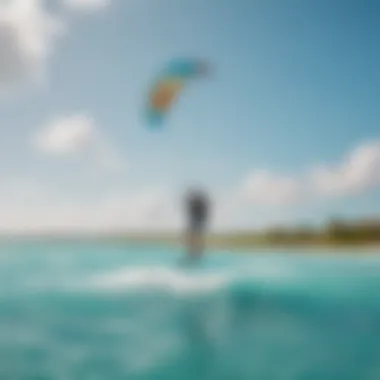Turks and Caicos Weather Insights for August Kitesurfing


Intro
Turks and Caicos is a destination renowned for its stunning beaches and aquatic activities. Among these activities, kitesurfing stands out for enthusiasts looking for adventure during the warm summer months. August, while generally hot, presents specific weather patterns that can impact kitesurfing experiences. This section explores the essential parameters to consider when planning a trip during this month.
Understanding August Weather in Turks and Caicos
In August, the region encounters a tropical climate. Average daytime temperatures often reach approximately 32 degrees Celsius (about 90 degrees Fahrenheit). Nights are typically cooler, falling to around 25 degrees Celsius (77 degrees Fahrenheit). These warm temperatures offer great conditions for kitesurfing but can lead to challenges if not managed correctly.
Precipitation also plays a role in outdoor activities. August is within the wet season, so occasional rain showers are common. However, they are usually brief, providing respite from the heat rather than prolonged disruptions.
Wind conditions are a particularly important factor for kitesurfers. Average wind speeds range from 15 to 25 knots, depending on daily variations. These wind conditions can vary greatly, with some days allowing for more intense sessions compared to others. Knowledge of wind patterns is crucial for any kitesurfer. Additionally, monitoring local forecasts will assist in adapting to the varying conditions.
Implications for Kitesurfing
Understanding the weather dynamics in August can influence choices related to kitesurfing. The warmth allows for prolonged sessions on the water, but safety remains paramount. Choosing the correct equipment, knowing when to go out, and being aware of local weather changes can greatly enhance the kitesurfing experience.
Kitesurfers need to select their times wisely, as afternoon storms can occur. Early mornings usually present calmer conditions, making them an ideal time for enthusiasts seeking both thrill and safety. Addressing these elements helps both beginners and seasoned kitesurfers plan trips that maximize enjoyment while remaining aware of potential risks.
Overall, August offers a mix of warmth, exciting winds, and the occasional rain. By understanding these aspects of the weather, kitesurfers can make informed choices that lead to successful outings.
Overview of August Weather in Turks and Caicos
Understanding the weather in Turks and Caicos during August is essential for anyone considering a trip, especially for kitesurfers and other outdoor enthusiasts. This month falls within the peak summer period, and each year can bring variances that significantly impact both enjoyment and safety.
August is characterized by warm temperatures, distinct wind patterns, and some potential for rainfall. Recognizing these elements can inform not only planning but also daily activities if you are seeking to maximize your adventure.
In particular, kitesurfers must take into account the interplay of temperature, wind speed, and precipitation. Each of these aspects contributes to favorable or adverse conditions on the water. For instance, higher temperatures can lead to turbulent thermal winds, which could affect kitesurfing performance.
Additionally, understanding how August's weather conditions might change throughout the month can aid in making informed choices about gear and timing for sessions. A smart approach to planning is critical.
Importance of Understanding Weather Patterns
The weather in August can be unpredictable, and a thorough grasp of recurring patterns aids in avoiding setbacks. Knowing the average high temperature and the likelihood of rain makes a significant difference in how you prepare.
For kitesurfing specifically, it’s vital to consider:
- Temperature Variability: Heat can affect hydration levels, and knowing peak times helps in managing energy.
- Wind Speeds: Varied wind conditions can influence skill levels and safety.
- Rain Patterns: Awareness of local rainfall reduces surprises and ensures that you can continue enjoying outdoor activities.
"Anticipating weather changes can ensure not just a smoother experience, but can also enhance safety measures in unpredictable conditions."
Arming yourself with knowledge about these various factors can elevate both safety and enjoyment. Overall, understanding August weather offers tangible benefits for planning your perfect trip.
Temperature Averages in August
Understanding temperature averages in August is crucial for anyone planning a visit to Turks and Caicos, particularly for activities like kitesurfing. Temperature seems like an easy aspect, yet it influences not only comfort but also performance in outdoor sports. Knowing typical daytime and nighttime temperatures can help visitors prepare adequately for their experience. In August, the average high temperature can reach around 89°F (32°C), while nighttime temperatures may drop to approximately 77°F (25°C). This variation indicates that while days can be hot, evenings remain relatively mild. The importance of comprehending these averages lies in enhancing one's overall enjoyment and ensuring proper gear is selected based on day and night conditions.
Daytime Temperatures
During the day in August, temperatures in Turks and Caicos are generally warm. The direct sunlight can make it feel even hotter, prompting the need for sun protection measures. High humidity accompanies these daytime temperatures, usually hovering around 77% on average. This humidity can affect how hot it truly feels. Thus, it's essential for kitesurfers to stay hydrated and wear appropriate clothing. Good choices might include light and breathable fabrics to maximize comfort while on the water. A few degrees can truly impact performance when kitesurfing; being aware of mid-afternoon heat might also affect when to schedule a session.
Nighttime Temperatures
Nighttime temperatures in August can be a comfortable respite from the daytime heat. Generally, the weather cools down to about 77°F (25°C). This decline in temperature can encourage night activities, making it a pleasant time for a beach stroll or enjoying a night out.


While the heat can dissipate, humidity remains high. This persistency can still make nights feel sticky or muggy. Kitesurfers or those who engage in evening activities should prepare for the warm yet comfortable nights. Including light layers can be a wise choice, especially if one remains out on the water too late, where breezy conditions may make it a bit cooler.
In summary, knowing temperature averages and their variations can inform not merely what to wear but also when to plan activities. Every detail, from hydration to clothing, significantly contributes to an enjoyable time in Turks and Caicos during August.
Precipitation Trends
Understanding precipitation trends is crucial for anyone planning a trip to Turks and Caicos in August. This month can experience varying rainfall patterns, which may influence outdoor plans, especially kitesurfing activities. As August falls within the Caribbean's wet season, expecting some rain is prudent. However, such precipitation can vary in intensity and duration. Knowing when and how often rain can occur helps in planning the right moments for outdoor sports or relaxation.
Rainfall Frequency
The frequency of rainfall during August is notable. On average, Turks and Caicos may see around 4 to 5 inches of rain throughout the month. Rainfall can happen fairly frequently, with showers often occurring in short bursts. These quick showers usually do not last for long, allowing ample time for enjoyable outdoor activities in between. The rain typically falls more often in the afternoons and evenings.
- Rain Events: While rare, heavier downpours can happen. These rain events typically last for a short time, often clearing up quickly.
- Monthly Average: Expect approximately 12 to 14 rainy days in August based on historical weather data.
This understanding can help in planning day-to-day activities, especially for kitesurfers who might want to avoid the rain and maximize their time on the water.
Impact on Kitesurfing Conditions
Precipitation not only affects visibility but also influences the overall conditions on the water. Rainfall can lead to changes in wind patterns and water conditions, important for kitesurfers. Here are several impacts to consider:
- Water Flow: Rain can affect the salinity of seawater, altering the water density. This may affect buoyancy and performance while kitesurfing.
- Wind Patterns: Generally, rainfall can lead to fluctuating wind conditions. After a rain shower, the air may cool slightly. This can temporarily change wind strength or direction, which might be favorable or unfavorable depending on the time.
- Visibility: A heavy rain may reduce visibility on the water, impacting navigation and safety.
Keeping these factors in mind is essential for a successful kitesurfing experience. Pay attention to local forecasts and be prepared to adapt to changing conditions during your session.
Wind Conditions in August
Understanding wind conditions in August is crucial for anyone planning to engage in kitesurfing or similar water sports in Turks and Caicos. Wind not only affects the maneuverability and performance of kitesurfing gear but also influences safety and enjoyment. For kitesurfers, being aware of typical wind speeds and the direction from which winds originate helps in selecting appropriate times and locations for their sessions. This information directly impacts overall experiences on the water, providing an edge for both enthusiasts and professionals alike.
Typical Wind Speeds
In August, average wind speeds in Turks and Caicos are generally consistent, ranging between 15 to 25 knots. These conditions are ideal for kitesurfers of various skill levels. Moderate winds can create thrilling rides without being overwhelmingly strong. For beginners, this wind speed allows for manageable sessions, while experienced riders can still enjoy jumps and tricks. Moreover, many kitesurfing schools operate during this month, taking full advantage of the reliable wind patterns.
Some key points to consider regarding wind speeds include:
- Safety Margin: Always monitor wind forecasts. When speeds exceed 25 knots, conditions can become challenging.
- Time of Day Impact: Wind can be lighter in the early morning and pick up in the afternoon.
- Equipment Selection: Choose kites that suit the wind conditions. Smaller kites might be necessary on windier days.
Wind Direction and Its Effects
Wind direction in August can vary, yet predominant easterly trade winds provide favorable conditions for kitesurfing. Understanding these directional patterns can alter kitesurfing experiences significantly. The eastern winds typically blow from the Atlantic Ocean, which often leads to smooth water surfaces, particularly in sheltered areas.
Effects of wind direction include:
- Launch Sites: The best launch spots are determined by prevailing wind direction. Familiarize yourself with local spots like Long Bay and Grace Bay, which align well with easterly winds.
- Wave Conditions: Wind direction not only affects the wind’s strength but also wave formation. On-shore winds can lead to choppy waves, while off-shore winds often result in flatter waters.
- Kite Control: The direction can impact how well a kitesurfer controls their equipment. Wind coming toward the shore can present challenges for landing and launching.
In August, a keen understanding of wind patterns and speeds is paramount for maximizing kitesurfing adventures.
By considering wind conditions, kitesurfers can improve performance, enhance safety, and ultimately elevate their overall enjoyment on the water.
Humidity and Its Influence
Understanding humidity is crucial for anyone considering kitesurfing in Turks and Caicos during August. High humidity levels can significantly impact the comfort of athletes and their performance on the water. Humidity refers to the amount of moisture in the air. In regions like Turks and Caicos, this metric can affect overall experience, making it vital to consider before planning your outdoor activities.
Additionally, humidity levels can influence wind patterns and precipitation, which are central to kitesurfing conditions. Knowing how humidity can shape the environment helps athletes prepare appropriately, whether they are choosing gear or scheduling their sessions. It is beneficial to grasp the average humidity levels and how they can affect comfort levels during outdoor activities.


Average Humidity Levels
In August, Turks and Caicos experiences relatively high humidity levels, often averaging between 75% to 85%. This range indicates a significant amount of moisture in the air, which means that even with moderate temperatures, the air may feel hotter than it actually is.
Factors affecting these humidity levels include:
- Proximity to the ocean
- Local vegetation
- Temperature fluctuations throughout the day
The high humidity is primarily due to the tropical climate in this region. It often leads to warm, sultry conditions, particularly during the afternoons. Moreover, this weather pattern can influence the timing of precipitation and associated wind conditions, critical for kitesurfing.
How Humidity Affects Comfort
High humidity can lead to discomfort for kitesurfers and even impact their performance. The body's natural way to cool itself is through the evaporation of sweat. However, when the air is saturated with moisture, evaporation slows down. This leads to increased body temperatures, making it seem warmer than the actual air temperature. Consequently, kitesurfers might experience:
- Fatigue more quickly than usual
- Increased risk of dehydration
- A greater feeling of exhaustion after each session
To counter these effects, it is essential to:
- Stay hydrated by drinking plenty of water
- Take regular breaks, especially in the early afternoon when humidity is at its peak
- Wear moisture-wicking clothing to facilitate evaporation
"Staying informed and adjusting to humidity levels can vastly improve comfort during kitesurfing in August."
Adapting to the humidity conditions during your trips can ensure that you enjoy kitesurfing while also prioritizing safety and comfort.
Ocean Conditions and Water Temperature
Understanding the ocean conditions and water temperature in Turks and Caicos during August is crucial for anyone planning a kitesurfing trip. The interplay between wind, wave patterns, and sea temperature influences not only the comfort and safety of the activities but also the performance for kitesurfers. August often presents unique conditions that can vary day to day, influencing decisions about gear and timing for sessions on the water.
Average Sea Surface Temperature
In August, the average sea surface temperature around Turks and Caicos typically hovers around 28 to 30 degrees Celsius. This level of warmth provides an inviting environment for water sports enthusiasts. The high temperatures allow for extended sessions without the discomfort of cold water. However, even in warm conditions, it is essential to remain aware of sun exposure and hydration to prevent fatigue during kitesurfing. Wetsuits are generally not required for kitesurfers, but some may prefer wearing rash guards or light protection against UV rays.
Wave Conditions for Kitesurfing
Wave conditions play a significant role in the experience of kitesurfing. In August, the wave heights can be moderately variable, commonly ranging from 0.5 to 2 meters depending on the day's weather patterns. Key factors that affect this include:
- Local Wind Patterns: Prevailing winds help shape wave conditions. Steady trade winds can result in more consistent and navigable waves.
- Tide Variations: The timing of tides can impact wave strength and frequency. A full tide often brings better surf conditions.
- Weather Fronts: Rapid weather changes can lead to sudden shifts in wave conditions. Awareness of forecasts can aid in planning.
Kitesurfers should evaluate the wave conditions before setting out. Jam-packed, choppy waters may be more challenging for newcomers but offer an exciting experience for seasoned riders. A good practice is to assess conditions at multiple spots, as certain areas will have more favorable wave heights and directions.
"The right wave can make or break a kitesurfing session. Understanding sea conditions is just as important as knowing the wind."
While August can be an intriguing month for kitesurfing in Turks and Caicos, recognizing the ocean conditions and temperatures ensures a better overall experience. This knowledge empowers kitesurfers to make informed decisions on gear, timing, and location, crucial aspects for enjoying this beautiful destination.
Kitesurfing Considerations in August
Kitesurfing is a popular sport in Turks and Caicos, especially during the month of August. Understanding the weather and how it affects kitesurfing can greatly enhance an athlete's experience on the water. In this section, we will explore essential aspects that can impact your kitesurfing adventure, highlighting the significance of gear selection and timing your sessions.
Best Practices for Gear Selection
Choosing the right gear is crucial for safe and enjoyable kitesurfing. In August, varying conditions such as wind speed and water temperature must guide your choices. Here are some key best practices:
- Kite Size: Select a kite size appropriate for August wind conditions. Typically, a medium to large kite works best due to fluctuating winds.
- Board Type: The board you choose often depends on your skill level and the nature of the water. For choppy conditions, a larger board can provide more stability.
- Wetsuit vs. Boardshorts: While the water temperature is generally warm, some may prefer a light wetsuit for added comfort. Boardshorts are usually sufficient for most kitesurfers, but consider personal comfort.
- Safety Gear: Always wear a harness and helmet. A quick-release system is also vital for emergencies, ensuring you can detach from your kite swiftly if necessary.


Investing in quality gear tailored for conditions in August can significantly impact your performance and safety while kitesurfing in Turks and Caicos.
Timing Your Sessions
The timing of your kitesurfing sessions in August can substantially influence your overall experience. Here are some considerations to keep in mind:
- Wind Patterns: Typically, mornings and late afternoons often see the most favorable wind conditions for kitesurfing. Midday can bring stronger and gustier winds, which can be challenging for less experienced kitesurfers.
- Tides: Understanding the tidal schedule is necessary too. For example, kiting during high tide can offer smoother waters, while low tide may expose some coral heads and other hazards.
- Weather Changes: August can be unpredictable with sudden thunderstorms. Check weather forecasts and be ready to adjust your plans accordingly. Noticing dark clouds may be a sign to head back to shore.
- Local Knowledge: If you're new to the area, consider connecting with local kitesurfing communities or clubs. Engaging with experienced locals can provide insight into the best spots and times for kitesurfing during August.
Safety Guidelines for August Kitesurfing
Safety is paramount for kitesurfers, particularly in the dynamic weather of August in Turks and Caicos. Understanding the local conditions and preparing accordingly can enhance both safety and enjoyment. This section highlights essential guidelines that every kitesurfer should consider to navigate the potential challenges unique to August weather.
Adapting to Changing Weather Conditions
Weather conditions in August can be unpredictable. Sudden shifts can occur, impacting wind, rain, and sea state. To ensure safety, kitesurfers should be vigilant about these changes. Firstly, recognize the signs of changing weather early. Darkening skies or shifting winds can signal imminent weather events.
Kitesurfers should also familiarize themselves with local weather patterns. Utilizing apps that provide real-time information on weather conditions is advisable. Services like Windy or Weather Underground can be invaluable. Always have alternative plans if the conditions become unsafe. Avoid surfing in stormy weather, as strong winds and rain can create hazardous conditions that can lead to accidents.
Furthermore, always wear a life jacket. This simple precaution increases safety and provides peace of mind in unpredictable conditions.
Staying Informed on Weather Updates
Being informed about weather updates is crucial for safe kitesurfing. Before heading out, check resources such as the National Weather Service or local forecasting websites. Look for bulletins specifically related to marine forecasts as they can provide vital insights into wind speeds and wave heights.
Regular updates are beneficial during your kitesurfing session. Consider subscribing to alerts or local kitesurfing groups on platforms like Reddit or Facebook for immediate updates from fellow kitesurfers. This peer communication can help you gauge the situation and adjust your plans quickly.
Additionally, joining local kitesurfing forums can provide you with firsthand information about current conditions and upcoming weather warnings. The many seasoned kitesurfers often share their experiences, making these forums valuable for both beginners and experienced athletes alike.
Staying informed allows you to make real-time decisions, ensuring you can take advantage of favorable conditions while avoiding danger.
By prioritizing safety and staying aware of weather updates, kitesurfers can significantly reduce their risk and enhance their overall experience on the water in August.
August Events and Activities in Turks and Caicos
Understanding events and activities in August is key for anyone considering a trip to the Turks and Caicos Islands. The weather is warm and often ideal for outdoor experiences, while the local culture thrives in this season. Engaging in local festivities or competitions enhances the travel experience. It allows visitors to connect more deeply with the culture. This enriched encounter makes the journey memorable and allows kitesurfers to meet like-minded individuals.
Local Festivals and Cultural Events
August brings multiple local festivals to Turks and Caicos, providing travelers the opportunity to immerse themselves in the vibrant culture. One notable celebration is the Conch Festival, which is held annually but varies slightly in timing. During this festival, local chefs showcase their culinary skills, specifically with conch dishes. Visitors can taste various preparations, experiencing authentic local flavors. Participating in such events not only supports the community but enhances one's understanding of the culture, history, and traditions of the islands.
Another significant cultural event during August is the National Heroes Day, observed on the last Monday of the month. This holiday recognizes the contributions of national heroes. It often includes parades, music, and dance performances. These gatherings are not just festive; they provide insight into the resilience and spirit of the people. For kitesurfers and outdoor lovers, these events can serve as perfect breaks between water activities.
Kitesurfing Competitions or Gatherings
August is also a popular month for kitesurfing competitions and gatherings in the Turks and Caicos. The consistent wind patterns during this time draw both amateurs and professionals to the shores. Events like the Turks and Caicos Kitesurfing Challenge often take place, attracting participants from various regions. These competitions serve multiple purposes. Besides being a platform to showcase skills, they promote camaraderie among kitesurfers.
Collective gatherings allow athletes to share tips on gear and techniques, effectively enriching their experience on the water. Additionally, witnessing competitive events can inspire beginners and motivate them to join the exciting world of kitesurfing. Local businesses often support these activities, providing opportunities for sponsorships and partnerships that further enhance the sports community.
In summary, the events in August add a layer of richness to the Turks and Caicos experience. They create a balance of adventure and cultural understanding, making a visit during this time particularly worthwhile.
End on August Weather Impact
Understanding the weather in Turks and Caicos during August is crucial for anyone planning to visit, especially kitesurfers and outdoor enthusiasts. The climatic conditions have a direct influence on various activities, from safety to enjoyment levels. By comprehending the key elements such as temperature fluctuations, rainfall patterns, and wind strength, travelers can make well-informed decisions about their trips.
Final Thoughts on Planning
When considering a trip during August, it is wise to reflect on several factors. Here are some considerations that can enhance the experience:
- Gear Selection: Effective gear is essential. Choosing equipment that withstands both the humidity and wind patterns is vital to ensure a better experience on the water.
- Informed Scheduling: Time your sessions to take advantage of favorable conditions. Check local forecasts frequently for sudden changes in weather.
- Event Awareness: Participate in local festivals or kitesurfing competitions, which can add excitement to your trip.
- Safety First: Be prepared for changes. Understanding how to adapt to shifting conditions helps ensure safety on the water.
Overall, the impact of August weather should not be underestimated. Meticulous planning will lead to a positive experience in Turks and Caicos, maximizing both fun and safety.







